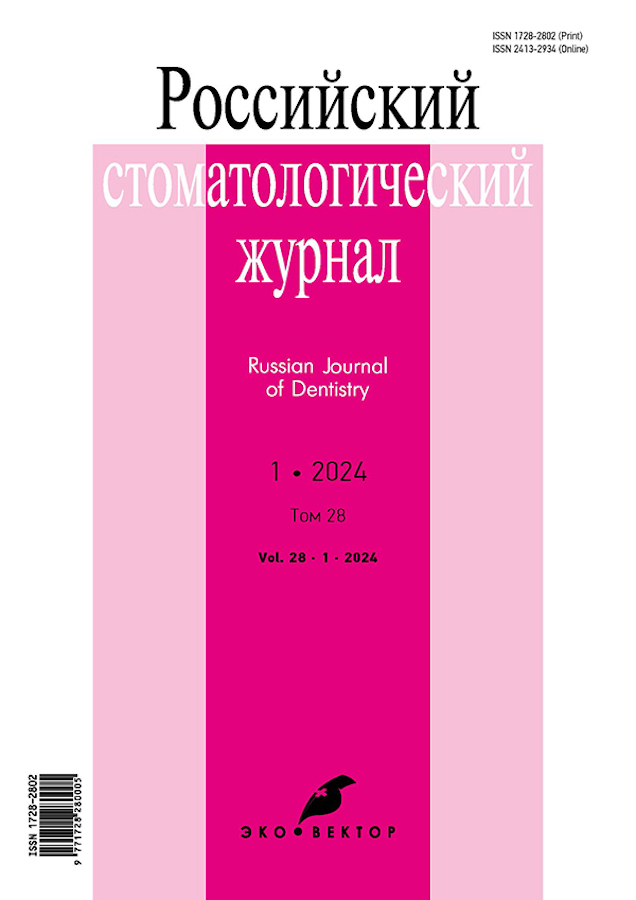Оценка повторяемости артикуляционных параметров при настройке виртуального артикулятора в программе Avantis 3D
- Авторы: Ковган Д.С.1, Ерохин В.А.2, Антоник П.М.3, Антоник М.М.3, Савельев В.В.1, Парунов В.А.1, Оганесян А.С.4
-
Учреждения:
- Российский университет дружбы народов имени Патриса Лумумбы
- Самарский государственный медицинский университет
- Российский университет медицины
- Первый Санкт-Петербургский государственный медицинский университет имени академика И.П. Павлова
- Выпуск: Том 28, № 1 (2024)
- Страницы: 99-105
- Раздел: Цифровая стоматология
- URL: https://bakhtiniada.ru/1728-2802/article/view/264185
- DOI: https://doi.org/10.17816/dent610446
- ID: 264185
Цитировать
Аннотация
Обоснование. Моделирование перемещения объёмного объекта нижней челюсти с зубными рядами в трёхмерном пространстве виртуального артикулятора требует точной настройки с учётом индивидуальных параметров для прецизионный работы стоматологов-ортопедов, стоматологов-ортодонтов и зубных техников. Одним из самых современных решений, включающих в себя виртуальный артикулятор, является российская программа Avantis 3D, которая упрощает и ускоряет функциональную диагностику за счёт создания 3D-сцены пациента.
Цель исследования — сравнить повторяемость артикуляционных параметров, получаемых при настройке отечественного виртуального артикулятора Avantis 3D, с использованием лабораторных и интраоральных сканов терминальных позиций нижней челюсти.
Методы. В исследовании участвовали 30 добровольцев в возрасте от 18 до 35 лет, из них 18 женщин и 12 мужчин.
Каждому участнику проведена компьютерная томография челюстно-лицевой области, включающей височно-нижнечелюстной сустав, в состоянии привычной окклюзии, получены одноэтапные силиконовые оттиски, отлиты гипсовые модели и изготовлены силиконовые регистраты прикуса трёх терминальных положений. Выполнено интраоральное сканирование верхней и нижней челюстей, получены оптические регистраты прикуса в положении максимального фиссурно-бугоркового контакта и в положениях терминальных позиций нижней челюсти, фиксируемых полученными ранее силиконовыми регистратами. Тот же протокол проводился и для гипсовых моделей зубных рядов пациентов и силиконовых регистратов терминальных положений. С использованием интраоральных сканов, оптических регистратов терминальных положений и компьютерных томограмм в программе Avantis 3D создали 3D-сцены и настроили виртуальный артикулятор. Для каждого пациента настройка виртуального артикулятора выполнена по 7 раз: с использованием данных с уровня интраорального сканера и с лабораторного уровня.
Воспроизводимость артикуляционных параметров оценивали для всех видов полученных сканов с учётом стандартного и индивидуального межмыщелкового расстояния для каждого пациента.
Результаты. Средние значения стандартного квадратичного отклонения артикуляционных параметров, полученных при создании 3D-сцен с использованием лабораторных сканов при индивидуальных и стандартных межмыщелковых расстояниях, выше аналогичных значений, полученных при использовании интраоральных сканов. Наибольшая разница зафиксирована при определении левого угла сагиттального суставного пути, при индивидуальном и при стандартном межмыщелковом расстоянии. Среднее значение стандартного квадратичного отклонения для лабораторных сканов моделей более чем в 2,5 раза превысило аналогичное значение для интраоральных сканов.
Заключение. На точность создания виртуального двойника пациента могут повлиять погрешности совмещения сканов, повторного сканирования, совмещения сканов и компьютерных томограмм, совмещения сканов и регистратов, а также наличие проникающих окклюзионных контактов между сканами зубных рядов.
Ключевые слова
Полный текст
Открыть статью на сайте журналаОб авторах
Дмитрий Сергеевич Ковган
Российский университет дружбы народов имени Патриса Лумумбы
Email: megaspayn@mail.ru
ORCID iD: 0009-0000-2390-0413
SPIN-код: 3243-8270
Россия, Москва
Владислав Алексеевич Ерохин
Самарский государственный медицинский университет
Автор, ответственный за переписку.
Email: vladalex.171097@mail.ru
ORCID iD: 0000-0003-1096-7568
SPIN-код: 4724-5883
Россия, Самара
Павел Михайлович Антоник
Российский университет медицины
Email: wow-oop@yandex.ru
ORCID iD: 0000-0001-5262-6679
SPIN-код: 7892-3432
Россия, Москва
Михаил Михайлович Антоник
Российский университет медицины
Email: wow-oop@yandex.ru
ORCID iD: 0000-0001-7902-1215
SPIN-код: 8713-4695
д-р мед. наук, профессор
Россия, МоскваВасилий Владимирович Савельев
Российский университет дружбы народов имени Патриса Лумумбы
Email: bazilsav@gmail.com
ORCID iD: 0000-0003-0437-1290
SPIN-код: 9363-9779
Россия, Москва
Виталий Анатольевич Парунов
Российский университет дружбы народов имени Патриса Лумумбы
Email: vparunov@mail.ru
ORCID iD: 0000-0003-2885-3657
SPIN-код: 8797-6513
д-р мед. наук, профессор
Россия, МоскваАртак Степанович Оганесян
Первый Санкт-Петербургский государственный медицинский университет имени академика И.П. Павлова
Email: Artac@yandex.ru
ORCID iD: 0009-0009-5127-7847
SPIN-код: 3051-2946
Россия, Санкт-Петербург
Список литературы
- Baldissara P., Koci B., Messias A.M., et al. Assessment of impression material accuracy in complete-arch restorations on four implants // J Prosthet Dent. 2021. Vol. 126, N 6. P. 763–771. doi: 10.1016/j.prosdent.2020.10.017
- Ряховский А.Н., Мурадов М.А., Ерохин В.А. Изучение точности виртуальной репозиции нижней челюсти // Стоматология. 2022. Т. 101, № 4. С. 53–60. EDN: KVGLBG doi: 10.17116/stomat202210104153
- Ryakhovsky A., Stanislav R. A new concept of 4d virtual planning in dentistry // Advances in Dentistry & Oral Health. 2020. Vol. 12. P. 00214. doi: 10.19080/ADOH.2019.11.555832
- Патент РФ на изобретение № 2567604 C2/10.11.2015. Кристенсен К.К., Фискер Р., Барт К.В., Поульсен Т.С. Динамический виртуальный артикулятор. EDN: HDZUWS doi: 10.1134/S0040363615100100
- Чхиквадзе Т.В., Бекреев В.В., Рощин Е.М., и др. Коррекция внутренних нарушений височно-нижнечелюстного сустава с использованием окклюзионных шин, изготовленных с помощью CAD/CAM-технологий // Современные технологии в медицине. 2019. Т. 11, № 3. С. 111–116. EDN: KFXJYB doi: 10.17691/stm2019.11.3.15
- Subeihi H., Hirayama H., Finkelman M., et al. Comparison of dimensional accuracy of digital dental models. In: Proceedings of the IADR/AADR/CADR General Session and Exhibition 2013; March 2013; Seattle, Washington. Режим доступа: https://www.researchgate.net/publication/266777620_Comparison_of_Dimensional_Accuracy_of_Digital_Dental_Models
- Diker B., Tak Ö. Comparing the accuracy of six intraoral scanners on prepared teeth and effect of scanning sequence // J Adv Prosthodont. 2020. Vol. 12, N 5. P. 299–306. doi: 10.4047/jap.2020.12.5.299
- Ряховский А.Н. Определение величины окклюзионных супраконтактов при виртуальном совмещении сканов в положении привычной окклюзии // Стоматология. 2021. Т. 100, № 3. С. 60–64. EDN: VKFZNG doi: 10.17116/stomat202110003160
Дополнительные файлы









